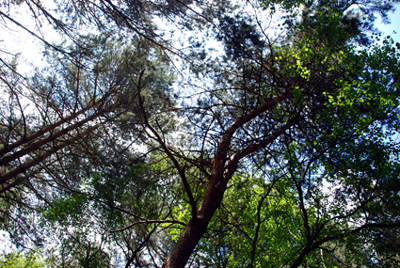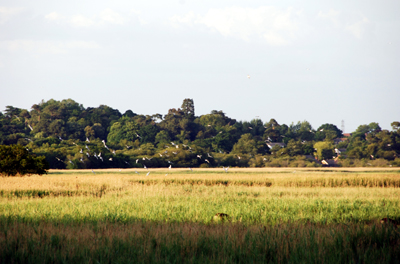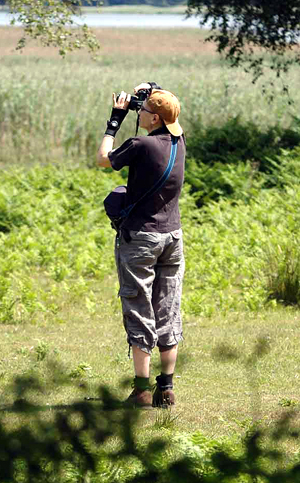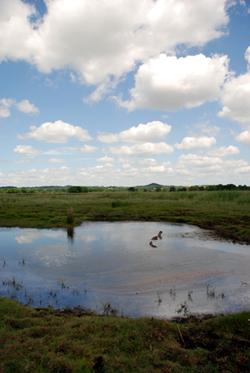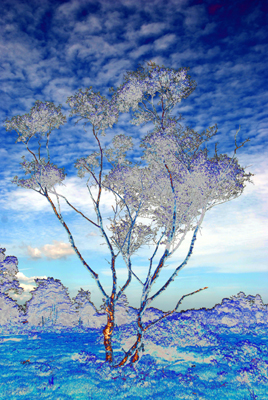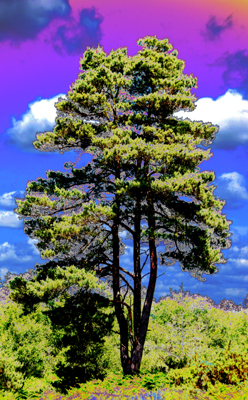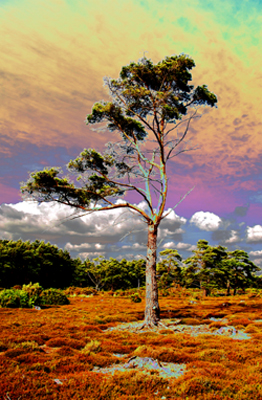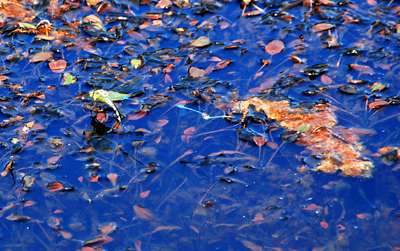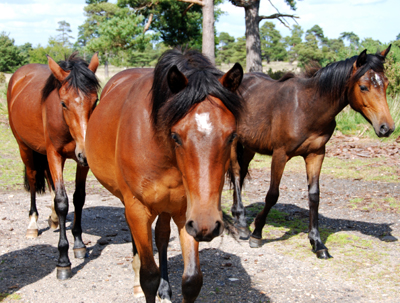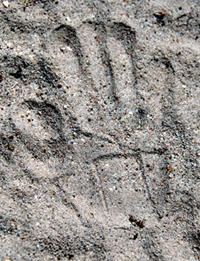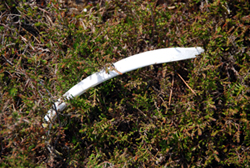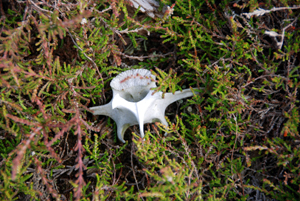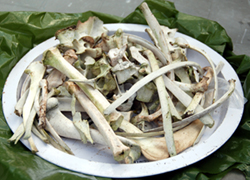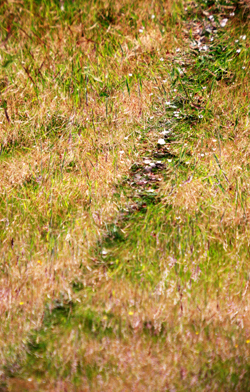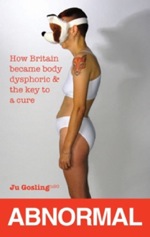Visit 25: 12 - 15 June 2009
We set off for Holton Lee on a sunny Friday morning in June. I've stayed at Julie's the night beforehand, as my kitchen is currently out of action while the ceiling is being replaced. (This is the tail end of a long story, involving a specialist bathroom company for disabled people which would be better based on a cowboy ranch than in Hampshire, the resulting waterfall through the kitchen ceiling, and 20 months' worth of letters and calls to try to get their insurance company to take responsibility for the resulting repairs.) In theory the work should be finished while we are away, but in fact it has been put on hold as the builders have found asbestos in the ceiling. This means that I will be without a kitchen - and an office, since it is full of kitchen equipment - for another ten days at least. I am therefore doubly pleased to be going to Holton Lee for a long weekend. Emily, who has been working as my PA for over six months now, meets us at mine and helps to load the van, and we have a fairly easy journey down, arriving about 3pm. It is my first visit to Holton Lee since January, but in fact I have been in the area quite a bit since then. My exhibition Abnormal: Towards a Scientific Model of Disability was at Bournemouth Library for most of March and April, and I had the opportunity to see at least some of my Holton Lee friends at the associated events. In particular, Ali from the Stables Studios came and helped me hang and later take down the exhibition, which was invaluable. Meanwhile Theresa, the new director, chaired my artist's talk in March, where I was interviewed by Jim Hunter, who is Vice Principal of Arts Institute Bournemouth and also a Holton Lee trustee. It was lovely to be able to bring the work so close and to show it to my local friends.
The reason why we have not been down to the caravan before now has been to give it a chance to dry out under its cover, after the roof was breached by last summer's torrential rains. (Ali had helped me deal with this too, bless her.) Added to which, we had to wait for it to be warm enough to camp in a tent if we find that the ceiling has collapsed completely when we open the door. Why am I having so many ceiling problems this week? And please don't let them come in threes! One major change at Holton Lee is the loss of the arts team. The Arts Council has cut their funding, along with many other Disability Arts organisations, so Trish and Hayley have been made redundant. This is very sad, particularly given the international reputation that Holton Lee has gained for its arts programme. However, I have had several meetings with Theresa in London and it seems as though the plans for the archive building will still go ahead. In the meantime, the goal is to complete the online version of the Disability Arts archive - what we have been calling NDACAWeb - once we can work out how to achieve this without having any staff!
I meet Ali by the studios and she comes with me to get the cover off the caravan, while Julie goes in search of a cup of tea after the long drive. (I do have a driving licence, but haven't been well enough to drive for a long time.) The caravan is dry, although all of the gaffer tape we put on the roof seams as a temporary repair last September has come off as it dried out. The ceiling is still up, but like my kitchen at home is sagging and may not stay there for much longer. In the past week I have made contact with a local mobile caravan repair service, as well as the Mustang Caravan Owners' Club (the caravan being a 1980 Mustang Arabian) and a service where you can order spare parts from caravan breakers, so I really hope it can be repaired. As well as the roof, I need to replace the hob and grill and a few smaller things such as wire fasteners for the lockers. The repair service will also check if it is fit to tow, although I have no plans to move it from Holton Lee yet. I hoped the repair men would turn up this afternoon, but they call to say they can't make it till Monday now. Ali and I are just sitting chatting when Trish turns up unexpectedly – it is lovely to see her. She is doing some freelance work for Holton Lee, hoping that we can get funding to catalogue the rest of the National Disability Arts Collection at Holton Lee. This would only be a small part of NDACAWeb, but a very important one. Ali and I have a drink with her and catch up; it is good not to be forced to lose touch by the Arts Council cuts. I have a lot of unpacking to do, as it is the first visit of the year - all the linen and other perishables have to go back into the caravan after a winter in my storage unit. It is lovely to be back, and it really doesn't feel like eight months since we were last in the caravan. It is strange not to go on to have a fish and chip supper at the stables, but Wally and Denise have finally been persuaded to take the weekends off after years of volunteering a seven-day week. However, we will see them tomorrow when the Trustees are holding a barbecue for the staff and volunteers.
Instead I pop over to see our neighbours at Ashtree Cottage, and ask them if we can hook up to their power supply again. This is particularly necessary as the battery, which feeds most of the caravan's power, is drained after the winter. The caravan has a slightly strange power system - the cooker and heater run on bottled gas, and the water pump, most lights and hoover point on the battery, but the fridge and the other power socket work off the mains. Anyway, they are kind enough to say yes, which is a great relief. We also meet their new dog, Spock, who is a rescue collie. He is a beautiful dog who reminds me of my last dog, a 'blue merle' Shetland sheepdog (Sheltie) called Jasper. Jasper died of cancer when he was eight, which is the point at which I got Genie. Genie seems to like Spock too, though is rather surprised to have such a close canine neighbour after three summers of being the only dog at this end of the site. It is going to be a particularly sociable weekend, as our friend Karen is coming down to give Holton Lee some feedback about how to improve the disabled access still further. Karen last came down nearly three years ago, as she's had a series of operations on her hands since which has made it impossible for her to drive long distances; it's great that she is up to coming down now. She is staying in the newly refurbished Gateway Cottage, along with her young dog Rosie - Rosie is enrolled in the same assistance dog training programme as Genie, Dog Aid. Karen texts me to say that she can't leave London until after 7pm because the traffic has become very heavy, so we collect her keys from the Barn to avoid disturbing the staff later and go to wait for her at the cottage.
As we go through the front door, the improvements to the cottage are striking. The kitchen and sitting room are now one large space, making it much easier for people with mobility problems to move round, and two dark rooms have become incredibly light and airy now that they have been joined up. The look of the cottage has been further improved by the addition of prints by Richard Jeffrey, who is a photographer I have met on a number of occasions at Holton Lee. Richard is a member of the Arts Aspect group, the committee who advises (and presumably currently leads) on Holton Lee's arts strategy, and has run various projects on the site. Apart from these the cottage is a little bare as improvements are still in hand, but as usual is spotlessly clean, including the linen. As the caravan hob has deteriorated over the past four summers from potentially dangerous to probably lethal, we use the kitchen to cook our supper while we are waiting for Karen and Rosie. Tinned spaghetti on toast (with marmite) is not everyone's idea of cordon bleu, but after a few days without a kitchen it still tastes good to me! Tomorrow we can go into Wareham and buy some proper food. In the meantime we watch the Big Brother eviction - yes, dear reader, it is that time of the year again already! Halfway through the programme Karen and Rosie arrive, to Genie's delight - she is obviously looking forward to bossing Rosie around and showing her the sights, and Karen is an old and dear friend of hers. We make sure they are settled and then drive back to the caravan - two grazing wild ponies move reluctantly off the road to let us past. A hooting owl makes Genie jump, and we are aware of many other pairs of eyes watching us in the dark. It is lovely to be back here.
The next morning, Saturday, we wake to find hordes of gulls circling low over the fields, calling and looking for food. They are all the same sort, so this must be a seaonal phenomenon. I try to photograph them, but am not particularly successful. Then we drive into Wareham while Karen and Rosie meet Theresa to look at the new Barn arrangements. As usual I find plenty to buy at the ironmongers, which thankfully must be one of the best-stocked in the country. Although I rely heavily on internet shopping, this shop has many products that I wouldn't even have dreamed existed. This includes a degreasing product called 'Elbow Grease', which I am intending to use on the caravan later. I also visit the wholefood shop to stock up while Julie visits the butcher, and am easily persuaded that I deserve a soya choc ice. Then we go into the Kucchi Bazaar, which is fast becoming one of our must-sees, and buy some birthday presents (and a few things for ourselves!). Wareham really is a lovely little town - one day we might actually get as far as the Saturday market by the river at the other end, but there is always so much to do that we haven't managed it yet. Instead we just stop to buy some strawberries at the end of the lane before driving up it. The lane is extremely pot-holed after the extreme weather of the past few years, and fundraising is taking place to try to replace it with a proper road - I vow to put my thinking cap on. We only go as far as Gateway Cottage on this occasion before stopping to have lunch with Karen and Rosie. Karen has been working hard all morning, and is ready for something to eat. I also have a shower in her bathroom, which is very welcome. Afterwards I go back to the caravan and begin the most urgent chores. I start with treating the rust on my scooter, which has suffered from being stored outside in London over the winter. Even with a cover, water splashes up inside, and because it has been such a hard, cold winter I have not had it out much. Emily has done a great job of cleaning and polishing it recently, but as on my previous visit in January, it is also suffering from a lingering smell of cat pee after being abused by the neighbourhood cats. I decide to wash the cover too, in the hope that this will help. Then Karen borrows the scooter and goes off with Julie, Genie and Rosie to explore and exercise the dogs, while I get on with the next fewjobs.
I treat the rust on the fridge and sink first, before tackling some sticky stains in the cupboard under the sink and the lockers above it. In keeping with the 1970s style of the caravan I am then intending to put down some sticky-backed plastic to cover up the remaining marks, but the 'elbow grease' cleaner the ironmonger has given me removes the stains completely. Amazing stuff, particularly considering the number of helpers who have failed to get it clean in the past. I even manage to clean the soot completely off the kettle for the first time in three years. There are a few stains left in the locker, but now lining paper will be fine - just as well as I realise for the first time what a very tricky shape it is compared to the cupboard shelves. However, I leave any 'normal' cleaning until I can get Emily to come down - I have had a lot of hospital treatment for my hands over the winter and now have them in splints, and I realise too late should not have done as much as I have already. Then the girls - canine and human - return, including an exhausted Genie. I quickly change out of my dirty jeans and head up to Faith House for the barbecue, which I am more than ready for! Genie is surprised to go out again so soon, but perks up quickly. The first people we see are Wally and Denise, who are looking much better for having some time to themselves. John and Johnny are also there from the stables, along with Louise from the Barn and other old friends. It is nice too to see Sir Tom and his daughters Bridget and Sarah - I last saw Sarah, the Chair of the Trustees, at my artist's talk in March. It's also good to talk to new people and to continue to get to know people who I have met briefly at past events. Genie begs patiently for a sausage, and eventually I share one with her when the rest move on to ice cream (as I can't digest cows' milk products, I comfort myself that I have had mine in advance this morning). I particularly enjoy talking to new friends and the Lees family about the history of Holton Lee and the Post Green community, who (to cut a long story extremely short) essentially founded Holton Lee as we know it today as a result of camping here. I learn that Holton Lee holds an archive of material from this time, and that Theresa has organised a project to catalogue it. I will be very interested to find out more in the future. I am convinced all over again that the most important aspect of my whole residency is not the work that I am making along the way, or the piece that I will eventually make for the building, but just the simple act of camping. (Or not so simple, if I am strictly honest.) And the documentation that is this Blog, of course. The barbecue comes to a natural end when light drizzle turns to rain. I remind myself to return the next day to see the exhibition at Faith House, which looks extremely intriguing through the glass wall at the front of the gallery. Johnny lends us the battery charger from the stables, so we set the caravan battery to charge in the common room, along with the scooters, before driving down to the cottage to watch Big Brother. (I haven't yet had time to set the television up in the caravan.) Genie finds some energy from somewhere, but both dogs are struggling to stay awake. As we drive back again, steam is rising from the lane where it is still hot from the sun.
On Sunday we lie in until around 9am, when we get up to a lovely sunny day. Karen comes over and we have coffee while I touch up the fridge enamel where I treated the rust the day before. Karen has borrowed a Tramper from the Barn today, but she realises that her camera batteries have been exhausted taking pictures of the access facilities so we decide to go back to Wareham before taking the dogs out for a run. We stop at another familiar shop on the way, next to the Gurkha-run restaurant on the Wareham Road, where I stock up on some canvas inkjet paper that I bought here last year and have since found very useful. The shop, based in what was originally a pottery, has such a range of goods that it is really like six or seven shops in one - plus a cafe as they also serve teas and ice creams. They don't have batteries, though, so we pick up these and the Sunday papers in Wareham before driving back to Holton Lee. Then we go for a long scooter ride through the woods and on to the heath. It is lovely to be free to roam the site at last, with most of my chores done. I feel so happy to be on the scooter, with the independence that it brings, and to be in such a peaceful place after the stress of dealing with the builders. It is also great to be working again, taking photographs of the deer pond, woods and heath as well as making a handprint and shadow self-portraits for my series. As always I look out for deer, but not very hopefully as most if not all will be in the reed beds by now. We stop briefly at the Chase Manhattan Hide, where the deer come at dawn and dusk to a pond at the edge of the reed beds to drink, but take a longer break at Horseshoe Pond where we watch dragon flies and other large and beautiful flying insects. They are completely mesmerising - like fairies - and it is hard to remember to use the camera.
After that we go and have lunch at the cottage - a cooked chicken which we'd bought in Wareham the day before. With these we have new potatoes, having found a pot left for us next to the caravan when we arrived on Friday (thank you, whoever it came from). Then we say goodbye to Karen and Rosie, who have to be back at work in the morning (as a trainee assistance dog, Rosie is already accompanying Karen everywhere). Julie goes on ahead of us, and as Genie and I cross the cattle grid just past the cottages I see a group of wild ponies coming towards us. Clearly they see me as a potential source of food, as they pick up speed and come straight at us. More nervous than I care to admit to Genie, we speed up the lane and thankfully they decide not to follow. How Julie would have laughed at us. We then have to take a detour to get back to the heath, Genie riding on the footplate as she has walked so far already in the last two days. Near the bee hives that supply the Holton Lee honey, I spot a rib bone sticking up out of the heather. It is surprisingly easy to see, given that many of the pines that have been cleared from the heath (to return it to a more natural, plant- and animal-friendly habitat) have left long splinters that have been bleached white in the sun. As I look round, I see more and more bones under clumps of heather, scattered around a 50 feet radius. It seems to be the body of a young deer that must have died last year and been eaten by foxes and other predators.
I have collected a few bones from the heath in the past, but have never seen as many as this before. I am keen to use them in some way in my future residency exhibition, and I pick up so many that I first fill my camera bag, and later my tripod bag. [Note to self; remember to pack carrier bags in the scooter bag for found objects.] Halfway through Julie calls to say that she has met Eddie, a volunteer in the stables, who has had an idea about how to mend the caravan roof seams with double-glazing tape. Apparently he has been thinking about it all winter! When we return to the caravan, I tidy up from the morning before feeding a very tired dog and typing up my notes for this Blog entry. Then we go out again with Julie to the edge of the reed beds, where some environmental volunteers are building an accessible boardwalk into the reed beds. This will make a wonderful place to take photographs and watch wildlife when it is finished. There are so very few places like this where disabled people can access the environment so completely. I stay for a little while after Julie leaves, and see some deer in the distance (naturally). I come back via the common room to pick up the contents of the cupboard under the sink, which Julie has rinsed out in the sink there, and as I come out I see the whole herd in the field beyond, including several white ones.
Back at the caravan, we watch Big Brother and eat strawberries before I let Genie out for the last time. I hear noises close by, so sweep the torch round into Twin Oak Tree field across the lane from us. The whole deer herd is only feet away from us, their eyes shining like dozens of pairs of mirrors which bob up and down as they feed. Amazingly, because they are used to artificial light and of course can't see me behind the torch, they remain there undisturbed. Genie, of course, is looking for rabbits and is blissfully unaware of the deer, so I stay there for some time, transfixed by the magic of the evening. First thing the next morning, the caravan repair man phones to say he is on his way and will be with me in five minutes. Rushing, I drop the gate latch on to the tip of the middle finger of my left hand - ouch! The bone is almost certainly broken, but there is nothing I can really do apart from ride to the common room to hold it under the cold tap. I return minutes later to hear that the repair man has already condemned the caravan as being too expensive to repair. He advises me to scrap it in the autumn and to buy a new one - he leaves me a local breaker's card. It is very depressing news. I feel upset that I haven't managed to look after the caravan better, both in terms of repairs and of covering it in the summer as well as the winter. One issue for me is always my lack of 'memory prompt' mechanism since I was ill in 2000, meaning that I don't always think of the obvious.
We go to the stables for coffee and consolation, but Eddie arrives shortly afterwards and refuses to accept the repair man's verdict. He comes and inspects the caravan, and suggests that the roof can be sealed with self-adhesive flashing on the seams. This is a brilliant idea, and I just wish it had occurred to me - oh for a memory prompt as I could have thought of this three years ago when I bought the caravan and first worried about the seams. Eddie also suggests supporting the ceiling on a batten, which should work too. He tells me to stop worrying and just leave him a key and permission to get on with it, which I do gladly. We decide to put the cover back on in the meantime as the caravan is completely dry - there is no smell of damp or black mould that would be a sign that the rest of the caravan is rotten too. Eddie's intervention is nothing short of miraculous, and I am so relieved. I seem to have run through a lot of emotions in the last hour, including the pain of my finger!
Feeling as if a great weight has been lifted, I go to see the exhibition in Faith House. The work is excellent, but I am confused because of the lack of labelling. With poor short-term memory, it is impossible for me to retain the information from the catalogue sheets long enough to work out which piece is which and by which artist. Trish's curatorial input is certainly missed. Finally, Genie and I go off with Julie to scoot around the fields that lead down to Poole Harbour. I have been talking to Theresa and Derek about my progressing Brigid's original plan to install a labyrinth at Holton Lee, and am keen to look at possible locations. (Brigid was the Personal Growth and Spirituality worker in 2007/8.) I hadn't known anything about labyrinths before Brigid and Derek started telling me about them, having confused them with mazes. Now I understand that a labyrinth can simply be marked out on the ground, and that there is one route through it to the centre without all the dead ends of the maze. Walking the labyrinth is a meditative experience, and Brigid's idea was that this would tie in with the 'Personal Growth and Spirituality Aspect' of Holton Lee.
My very rough idea is to use the natural materials from Holton Lee to create a labyrinth that will degrade naturally over time, leaving no lasting mark on the landscape (although it should also have the ability to be maintained so it is as temporary or long-lasting as is desired). As with my shadow self-portrait series, I am very interested in environmental art that makes no permanent change or transformation of the landscape. I want to create something very simple in the centre - perhaps one of the large logs that are stacked at the far side of the Barn for a seat, and a pool of water in stone to reflect the sky and aid thought. I had thought about Derek and I marking out the shape - we had already decided on a circular labyrinth - but since meeting artist Susan Austin in January and again at my exhibition workshop in April, I have decided to work with her instead. Susan is using her wheelchair and line-marking paint to leave traces of her wheelchair use as installations, and has already left some of these on the lane as part of her recent exhibition in Faith House, Traces from a Wheelchair. (Susan won the Judge's Choice award at the Holton Lee Open exhibition last year.) She has been referencing my work within her practice and we are keen to work together, so I will propose that we create the outline using her techniques. Julie will document it, of course, and the resulting video might make an installation in itself.
Then my idea is to create the labyrinth initially with pine cones from the woods, perhaps involving one of the groups of school students who visit the site to lay them out. After that, and probably the following year, I would like to use some of the pine trunks and branches that are being removed from the heath to create a henge-type structure. This would probably require the involvement of the army, who volunteer occasionally on the site, so this can only be an ambition at present. I decide that the far side of Celebration Field is unsuitable as a possible location, but in the process get very stuck as the field is pitted with mole hills as well as bristling with thistles etc. In order to make it less likely that the scooter will tip over, I start to follow the deer paths across it. In a tribute to Richard Long - the god of environmental art, and how I am looking forward to seeing his retrospective at Tate Britain soon - I decide to start a new project following animal paths around the site and photographing them. Richard Long documents his own walks and the traces they leave, of course, but when you use a mobility scooter, albeit an off-road one, it is better to think on a smaller scale! Eventually I find some better alternatives as possible locations to suggest, and head back to the caravan. There is always so much to do here, and it is such an inspiring place to make work, that I can't find it in my heart to regret entirely that the building project has been delayed still further. One day I might even become more familiar with the birds, flowers and insects that abound here - learning about trees to the point where I recognise individual ones as old friends has already brought me a long way from the Essex marshes of my birth and Thames marshes of my home. I load the van extremely reluctantly to return to London, and hope to be back again very soon. Click here to view more psychedelic trees and other images from Holton Lee Click here to read the next entry Click here to return to the blog entries Click here to return to the top of the page All contents © 2006-9 |
|||||||||||||||||

